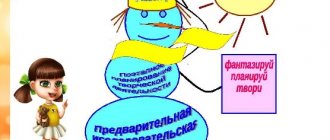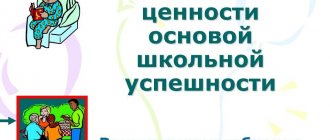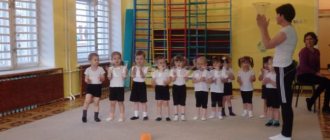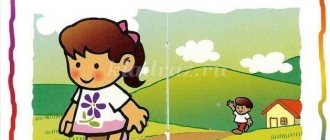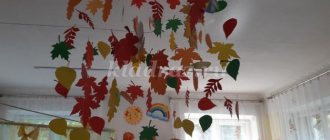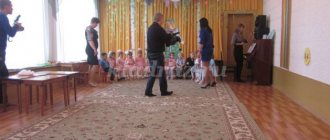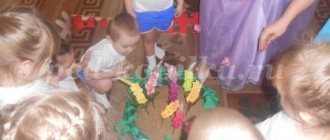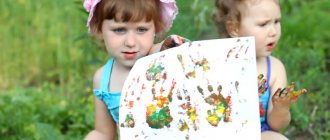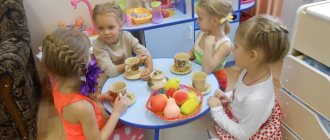Summary of the regime moment "Lunch" in the second junior group
Summary of the regime moment. Dinner. (second junior group)
Goals:
1. Continue to protect and improve the health of children.
2. Continue to develop a culture of behavior while eating: use cutlery correctly (tablespoon, teaspoon, fork); ability to use a napkin carefully; do not crumble bread, chew food with your mouth closed, do not talk while eating.
3. Cultivate politeness (thank you for food, the need for cleanliness and neatness.
Preliminary work:
1. Situational conversations about the benefits of healthy food and table etiquette.
2. S/r games “Let’s treat the doll to tea”, “Cook borscht”, “How Vanya offended the guests”, etc.
3. Reading works of fiction on the topic of etiquette at the table (“Etiquette” by Yuri Chichev)
Individual work:
Ksyusha S. – consolidate the ability to sit up straight
Vanya Al. - motivate to eat
Leva – strengthen the skills of holding a spoon correctly
Progress of the regime moment:
The teacher's assistant sets the tables, while the children are with the teacher at this time.
V-l: The Vanya doll came to visit us. Who do you think he is? (cook) Let's repeat together - “cook”
Why do you think so?
What does a chef do? (children's answers)
V-l: What do you think they will give us for lunch now? (children's answers - soup, second course, compote)
Vs: That's right, soup. What can you make soup from? (children's answer). That's right, they put meat, potatoes, carrots, and onions in the soup. Ksyusha, what do they put in the soup?
— While we were talking, Tatyana Viktorovna set the tables and invited us to the table.
But in order to sit down at the table, what needs to be done? (Wash the hands)
How should you wash your hands properly? (Do not splash, lather with soap, rinse, dry with your own towel) And now the girls go to wash their hands, and the boys and Vanya look to see if the girls are doing everything right
The girls go to wash their hands, the boys stand and watch.
Warm water
I wash my hands clean.
I'll take a bar of soap
And I rub my palms with them.
V-l comments on the actions
Vs: We lather our hands with soap. We wash it off. And wipe dry with a towel. Well done girls! Go sit at the table, and Vanya will watch the boys wash their hands.
Doll Vanya: Boys, can you dry yourself with someone else’s towel? (no) How do you find your towel? (based on the picture and photograph) Is it possible to splash? (no, why? (children's answers)
Boys wash their hands.
V-l comments on the children’s actions and praises them.
Vs: We lather our hands with soap. We wash it off. And wipe dry with a towel. Well done boys! Go sit at the table
The boys sit down at the table.
Having placed the children at the tables, the teacher talks about what is offered to the children for lunch today (lunch menu) and wishes them a bon appetit.
Vs: And we’ll put Vanya in the corner of duty so that he can see everyone.
The teacher pays attention to the children’s posture while eating and carries out individual work to consolidate the skills of using cutlery.
Vl: Don’t forget that we hold the spoon in our right hand and the bread in our left. We sit upright at the table, our back is straight, our legs are also straight. Vanya also told me that he brought you small gifts. But he will give them only to those whose plates are all clean. Leva, don’t forget that you need to hold the spoon in your right hand.
During meals, the teacher conducts individual work with children: praises children for neatness, leisurely behavior, and cultural skills (using a napkin after eating). It also talks about what the dishes consist of.
V-l: Well done! Eat carefully. Vanya likes the way you eat.
The teacher's assistant organizes a gradual change of dishes
V-l: Well done! Don’t forget that after eating we wipe our mouths with a napkin and say “Thank you! »
Children who have finished eating get up from the table and say “thank you.” They bring a plate and a mug. And they go to undress.
V-l: Well done! For your clean plates, Vanya gives you these stickers.
When all the children have left the table, the teacher helps the children get ready for bed.
K.V. gives out stickers for clean plates
Summary of educational activities in the younger group: “Rules of behavior for well-mannered children.”
Summary of GCD in the junior group:
"Rules of conduct for well-mannered children."
Program content
: Continue to introduce children to the rules of safe behavior in kindergarten and at home. Learn to follow these rules in the environment. Foster a culture of behavior. Contribute to the unity of the children's team.
Material:
toys: Dunno, bunny with a bandaged paw, doll, bear, illustrations for situations
Progress:
Children come to visit: Dunno, a bunny, a doll, a bear. Children greet guests. The teacher asks why they are so sad and not cheerful, what happened to you?
Dunno: It hurts me a lot. I hit my head on a closet and now I have a big bump on my forehead. It hurts me-oh-oh-oh.
- Dunno, how did this happen?
Dunno: Now I was playing with the guys in another group. We were running around, having fun, scattering all the toys, so I tripped over a cube, fell and hit my head on the closet. Oh, how it hurts me-o-o-o.
-Guys, tell me, is it possible to run around in a group and throw toys around? (No you can not)
-Why can’t you run in a group or apartment? (You can fall, bump, get hurt and it will be very painful).
-Where can I run? (in the gym, on the street, on the playground)
— Got it, Dunno, how you need to behave safely so that trouble doesn’t happen to you?
Dunno: Now I know this, thank you guys for teaching me how to behave correctly.
-What happened to you, little bunny? Why is your paw bandaged?
Bunny: I spilled hot tea on myself when the little fox and I were having breakfast, playing around and fidgeting around the table. So I burned my paw, now I can’t jump or play!
- Guys, let’s teach the little bunny how to sit at the table correctly too. Tell me, how do well-mannered children behave during meals? (You can't talk, move around, play)
- That's right, otherwise you might choke or spill hot food on yourself. Listen to how you should behave at the table.
Don't spill it on yourself
Hot soup or tea.
Be careful when
Your food is hot.
Eat calmly, don't fidget
Don't hover over the plate!
Bunny: Thank you children for the advice, now I know how to behave at the table!
Physical activity: Let's play with the bunny and make him laugh.
P/i “The gray bunny is sitting”
Then I turn to the doll Tanya.
- What happened to you, are you also all pale and sick?
Doll: My stomach hurts. I ate an apple and a pear on the street.
- Tanya, how could you eat unwashed fruit, and even with dirty hands? You need to be sent to a doctor urgently.
-Guys, when we want to eat something, what should we do first? (wash your hands with soap)
-Is it possible to eat dirty vegetables and fruits? (You can’t, your stomach will hurt)
Card index of safety conversations in the second junior group
Children 3-4 years old often become victims of accidents, so special attention should be paid to safety topics in preschool educational institutions.
For your information! It is important to convey information to parents of children about the need for prevention. At parent meetings, issue reminders and explain how best to convey information to children at this age.
Conversations are conducted with game elements, listening to theme songs, poems, viewing handouts (illustrations from books, cards, posters), as well as films and cartoons on relevant topics.
Minutes of safety in the junior group (file of topics):
- “Poisonous berries” (talk about poisonous berries, why they should not be eaten, especially pay attention to poisonous berries that are similar to edible ones).
- “Stop, dear!” (rules for crossing the roadway, rules of behavior near the road).
- “Red, yellow, green” (talk about traffic lights, what they are needed for, and what their colors mean, talk about the types of traffic lights).
- “Zebra is a striped friend. Safety at a pedestrian crossing."
- "Traveling in a car."
- “Bus, trolleybus, tram - open your doors!”
- “I’m lost” (rules of behavior in case of loss in a shopping center, at a train station or at the airport, on the street, in the forest).
- "Stranger."
- "What is height?"
- "Oh, fire!" (prohibition on playing with matches, lighters, gas burners; children's pranks with fire; basic rules for extinguishing a fire).
- "Dangerous electricity."
- "Who can help?"
Security Talk
- “I know how to make phone calls” (emergency services, relatives).
- “Be careful, ticks!”
- “How to behave with someone else’s dog” (discussion about precautions when communicating with dogs, explain how to properly establish contact if you want to communicate, how to give treats, behave when meeting an aggressive dog)?
- “Who is knocking at my house?”
- "Poisonous mushrooms."
- “Rabies, what should even a child know?”
- "Rules of behavior in a thunderstorm."
- “How to behave in strong winds?”
Drawing lesson on the theme “Girl dancing” for the middle group
Summary of the morning segment of time (junior group)
Municipal preschool educational institution kindergarten No. 4 “Solnyshko” g/o Vlasikha
Summary of the morning segment of time for the junior group.
Educator: Efimik Marina Alekseevna
Program content:
- Admitting children to the group and talking with parents about the children’s health status.
- Continue to work on developing the habit in children of saying hello when entering a group.
- Continue to develop children’s cultural and hygienic skills (toilet, washing, ability to use their own towel), the need to perform a set of morning exercises.
- Continue to cultivate friendly relationships with children.
- Continue to develop work skills, teach children to put toys back in their place.
- Preparation for class
Reception of children.
The teacher receives the children, greets the guardians, the children, asks about the child’s mood, what he saw on the way when he went to kindergarten, notes how the child is dressed (nice, very warm or vice versa), how he slept at home, what a good toy he has (if he brought it), whether he was fed in the morning, whether he had a handkerchief.
When a child enters the group, he says hello, if he refuses to say hello, then the teacher says: “Well, it’s okay, tomorrow Vanya you will definitely say hello.”
The kids have all gathered. The teacher says: “Guys, you woke up a long time ago and came to kindergarten, but the doll Masha is still sleeping. Let's wake her up (they go to the bed and wake her up) “get up Masha, it’s time to do exercises!” The doll wakes up and says: “But I don’t know how.”
Educator: “Guys, let’s teach the doll how to do exercises.
Charging begins: “Birds.”
1. Introductory walking. (30 sec.)
Walking after each other and running.
Formation in a circle.
2. “The birds are flapping their wings.”
I.p Legs slightly apart, arms down. Raise your Hands up and say: “We flew, we flew on Sali’s head” 4-5 rubles).
3. “The birds are pecking the grains.” I.p Legs slightly apart, hands on the belt. Sit down, tap your palms on your knees (3-4 times).
4. “Birds drink water”
I.p. Legs slightly apart, lean forward. Take your hands back. Straighten up (3-4 rubles).
5. “Birds are jumping.”
Then the teacher pays attention to the doll Masha. The doll really liked the exercise: “Thank you guys, now I will also do exercises.” Now guys, says the teacher, we will wash our hands and go have breakfast. First we need to roll up our sleeves and wash our hands. What nursery rhyme do we know about water? “Wash my face with some water...” says the teacher. We wash our hands with soap and dry them with our towel, making sure that children do not spill water when washing. Then the teacher and nanny give the bibs to the children and sit them down to have breakfast. The teacher says, “Soroka, magpie, she cooked porridge and fed the children.” She gave it to Nastya, she gave it to Yura, she gave it to Lera (she gave porridge to all the children). Eat, guys, bon appetit. Make sure that the spoon is in your right hand, that you eat carefully, don’t wet yourself, don’t take food with your hands, don’t disturb your friends while eating, and don’t leave the table without finishing your meal. They said “thank you.” The teacher feeds those children who have not finished eating. After eating, the teacher takes the children to wash. We are preparing for a lesson on the topic: “The bunny came to visit us.”
